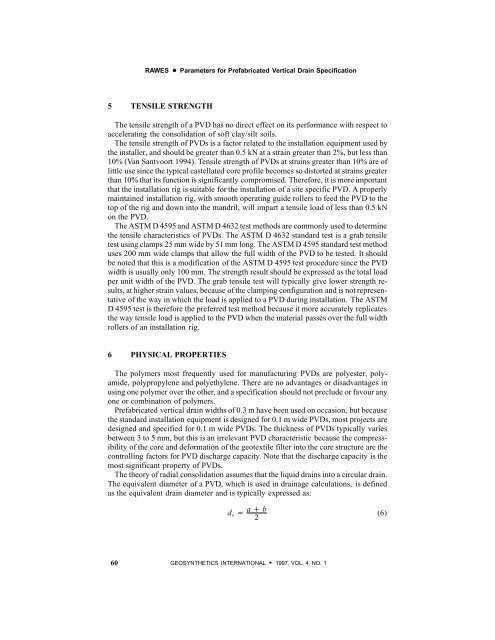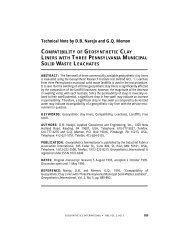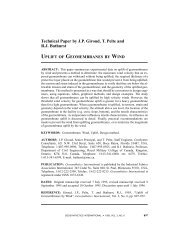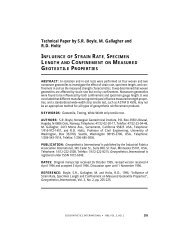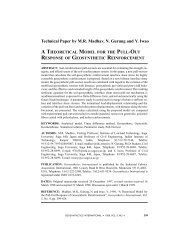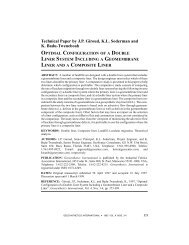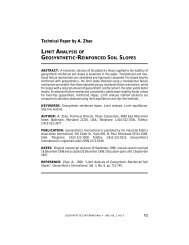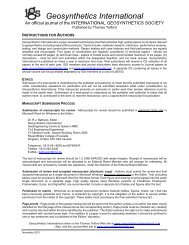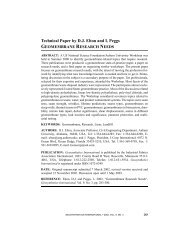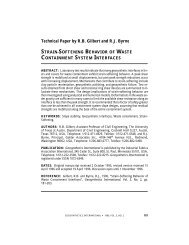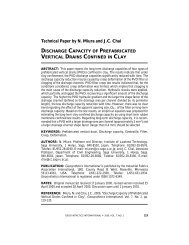Technical Paper by B.C. Rawes - IGS - International Geosynthetics ...
Technical Paper by B.C. Rawes - IGS - International Geosynthetics ...
Technical Paper by B.C. Rawes - IGS - International Geosynthetics ...
You also want an ePaper? Increase the reach of your titles
YUMPU automatically turns print PDFs into web optimized ePapers that Google loves.
RAWES D Parameters for Prefabricated Vertical Drain Specification<br />
5 TENSILE STRENGTH<br />
The tensile strength of a PVD has no direct effect on its performance with respect to<br />
accelerating the consolidation of soft clay/silt soils.<br />
The tensile strength of PVDs is a factor related to the installation equipment used <strong>by</strong><br />
the installer, and should be greater than 0.5 kN at a strain greater than 2%, but less than<br />
10% (Van Santvoort 1994). Tensile strength of PVDs at strains greater than 10% are of<br />
little use since the typical castellated core profile becomes so distorted at strains greater<br />
than 10% that its function is significantly compromised. Therefore, it is more important<br />
that the installation rig is suitable for the installation of a site specific PVD. A properly<br />
maintained installation rig, with smooth operating guide rollers to feed the PVD to the<br />
top of the rig and down into the mandril, will impart a tensile load of less than 0.5 kN<br />
on the PVD.<br />
The ASTM D 4595 and ASTM D 4632 test methods are commonly used to determine<br />
the tensile characteristics of PVDs. The ASTM D 4632 standard test is a grab tensile<br />
test using clamps 25 mm wide <strong>by</strong> 51 mm long. The ASTM D 4595 standard test method<br />
uses 200 mm wide clamps that allow the full width of the PVD to be tested. It should<br />
be noted that this is a modification of the ASTM D 4595 test procedure since the PVD<br />
width is usually only 100 mm. The strength result should be expressed as the total load<br />
per unit width of the PVD. The grab tensile test will typically give lower strength results,<br />
at higher strain values, because of the clamping configuration and is not representative<br />
of the way in which the load is applied to a PVD during installation. The ASTM<br />
D 4595 test is therefore the preferred test method because it more accurately replicates<br />
the way tensile load is applied to the PVD when the material passes over the full width<br />
rollers of an installation rig.<br />
6 PHYSICAL PROPERTIES<br />
The polymers most frequently used for manufacturing PVDs are polyester, polyamide,<br />
polypropylene and polyethylene. There are no advantages or disadvantages in<br />
using one polymer over the other, and a specification should not preclude or favour any<br />
one or combination of polymers.<br />
Prefabricated vertical drain widths of 0.3 m have been used on occasion, but because<br />
the standard installation equipment is designed for 0.1 m wide PVDs, most projects are<br />
designed and specified for 0.1 m wide PVDs. The thickness of PVDs typically varies<br />
between 3 to 5 mm, but this is an irrelevant PVD characteristic because the compressibility<br />
of the core and deformation of the geotextile filter into the core structure are the<br />
controlling factors for PVD discharge capacity. Note that the discharge capacity is the<br />
most significant property of PVDs.<br />
The theory of radial consolidation assumes that the liquid drains into a circular drain.<br />
The equivalent diameter of a PVD, which is used in drainage calculations, is defined<br />
as the equivalent drain diameter and is typically expressed as:<br />
d e = a + b<br />
2<br />
(6)<br />
60 GEOSYNTHETICS INTERNATIONAL S 1997, VOL. 4, NO. 1


